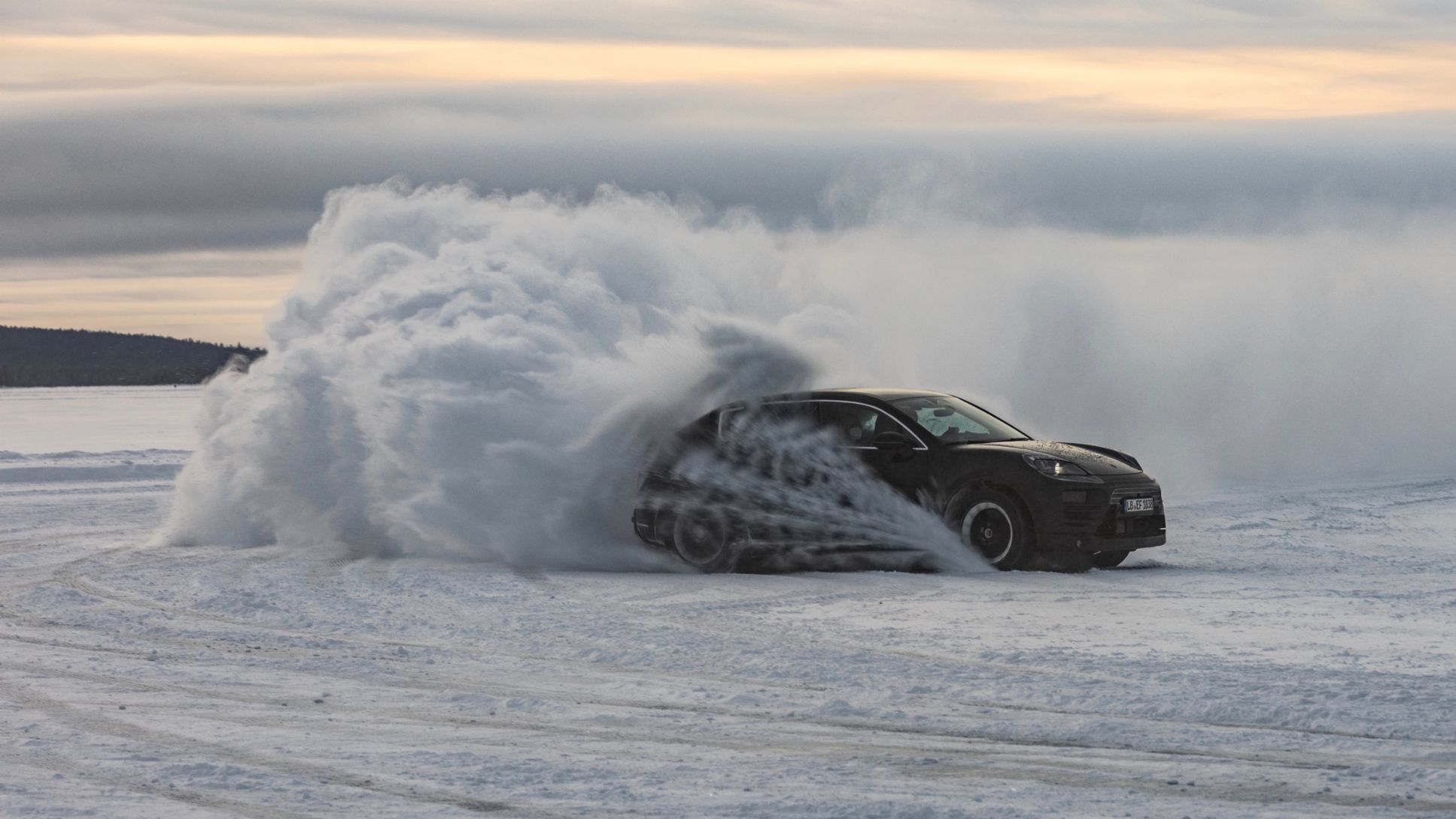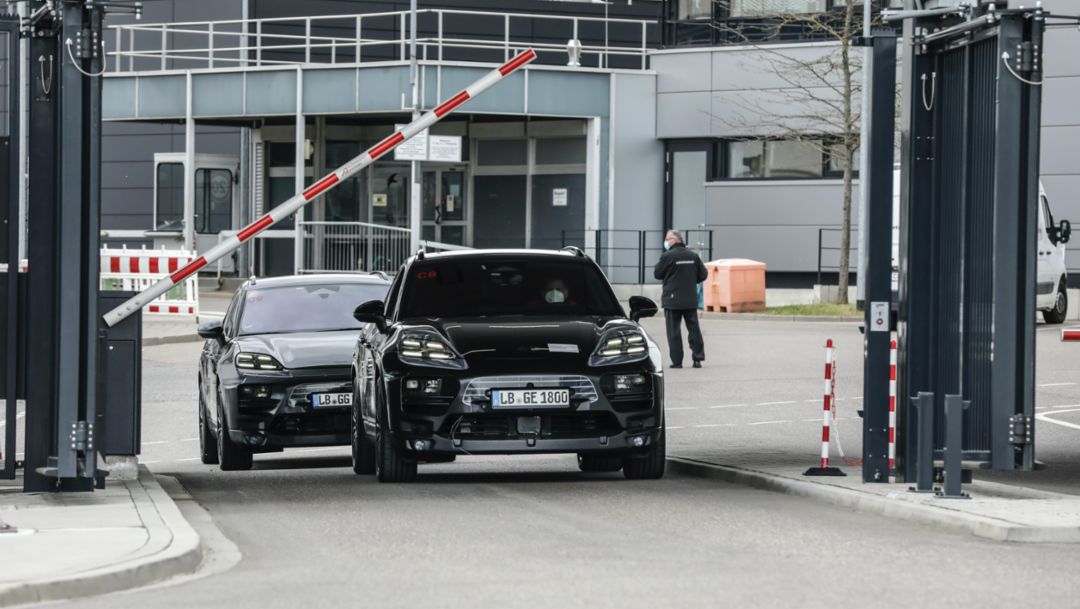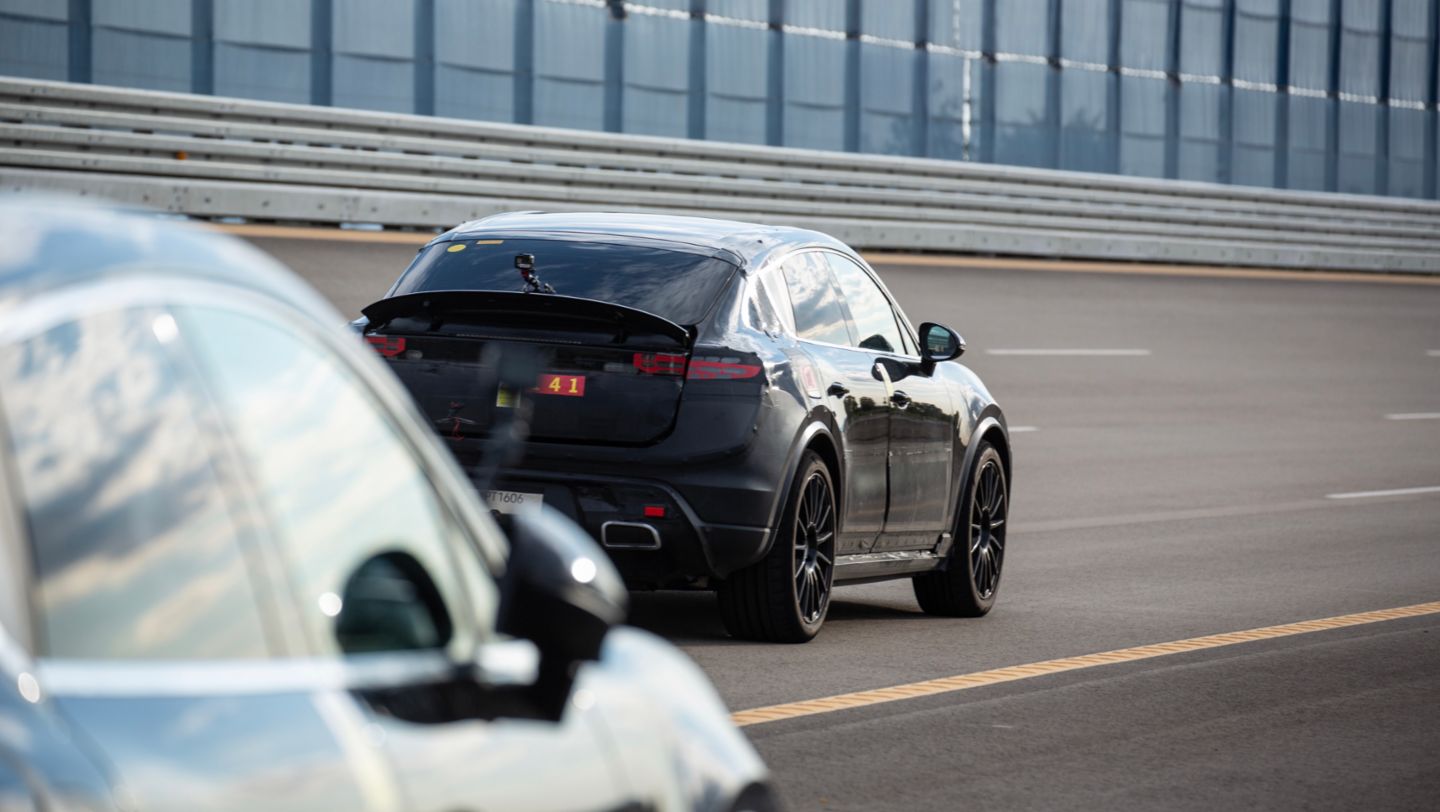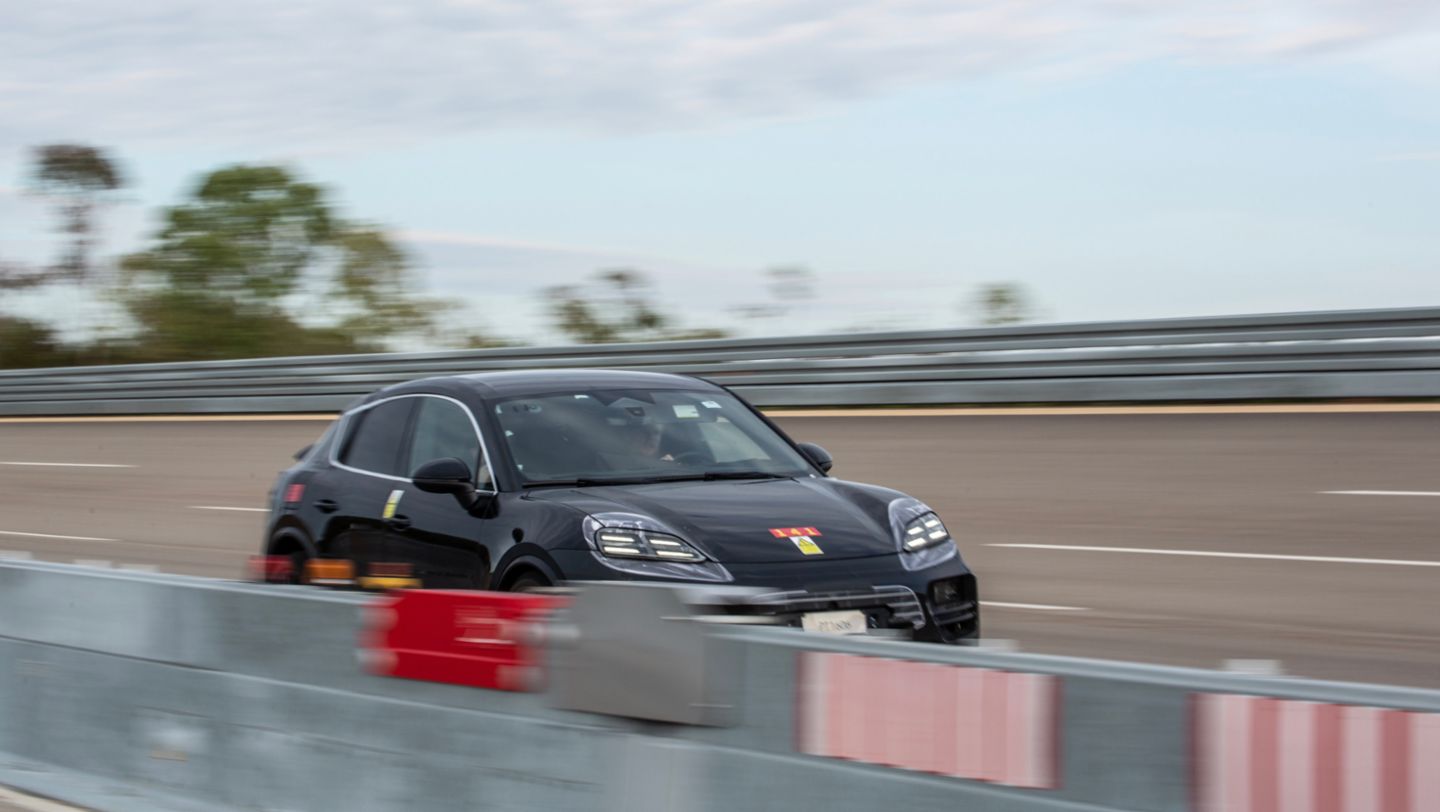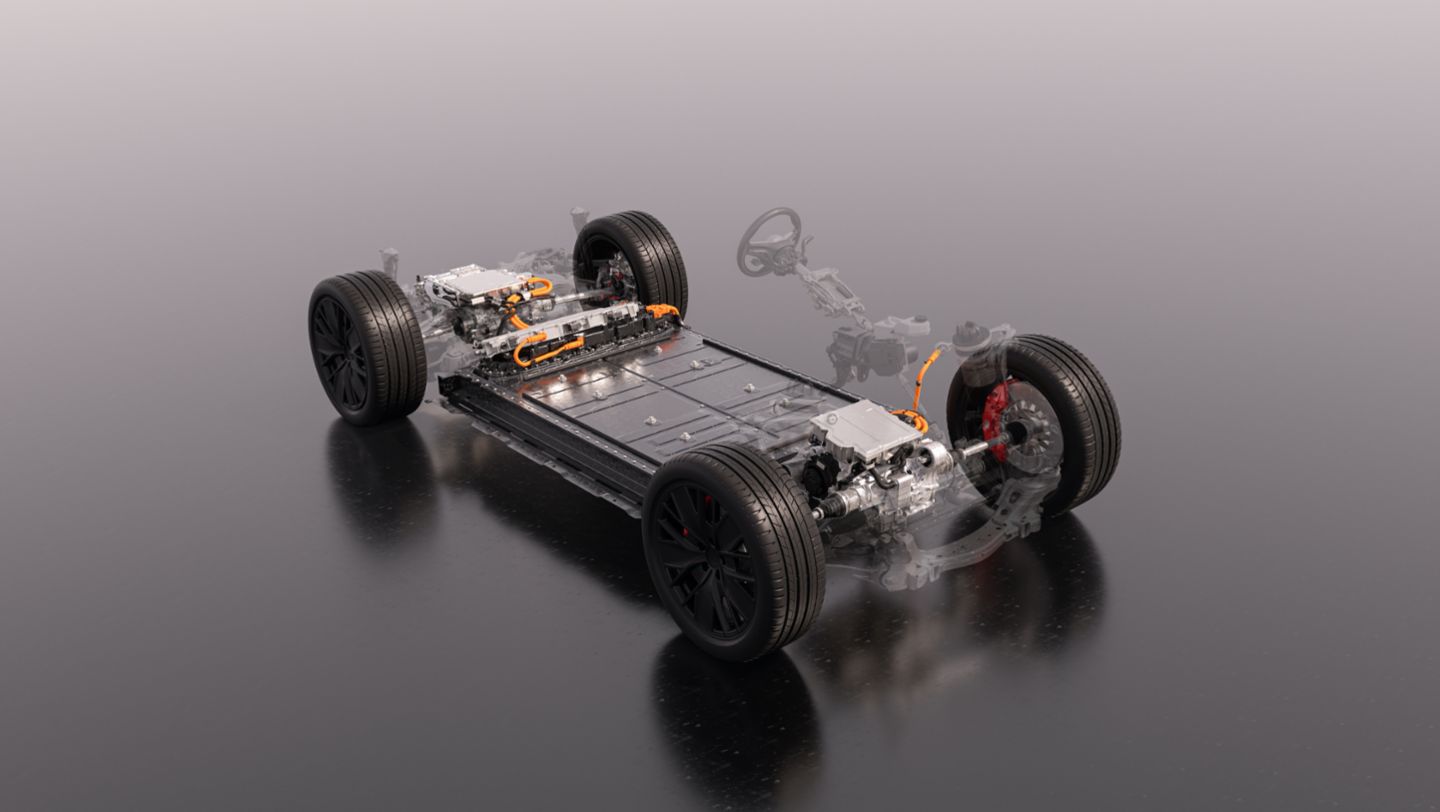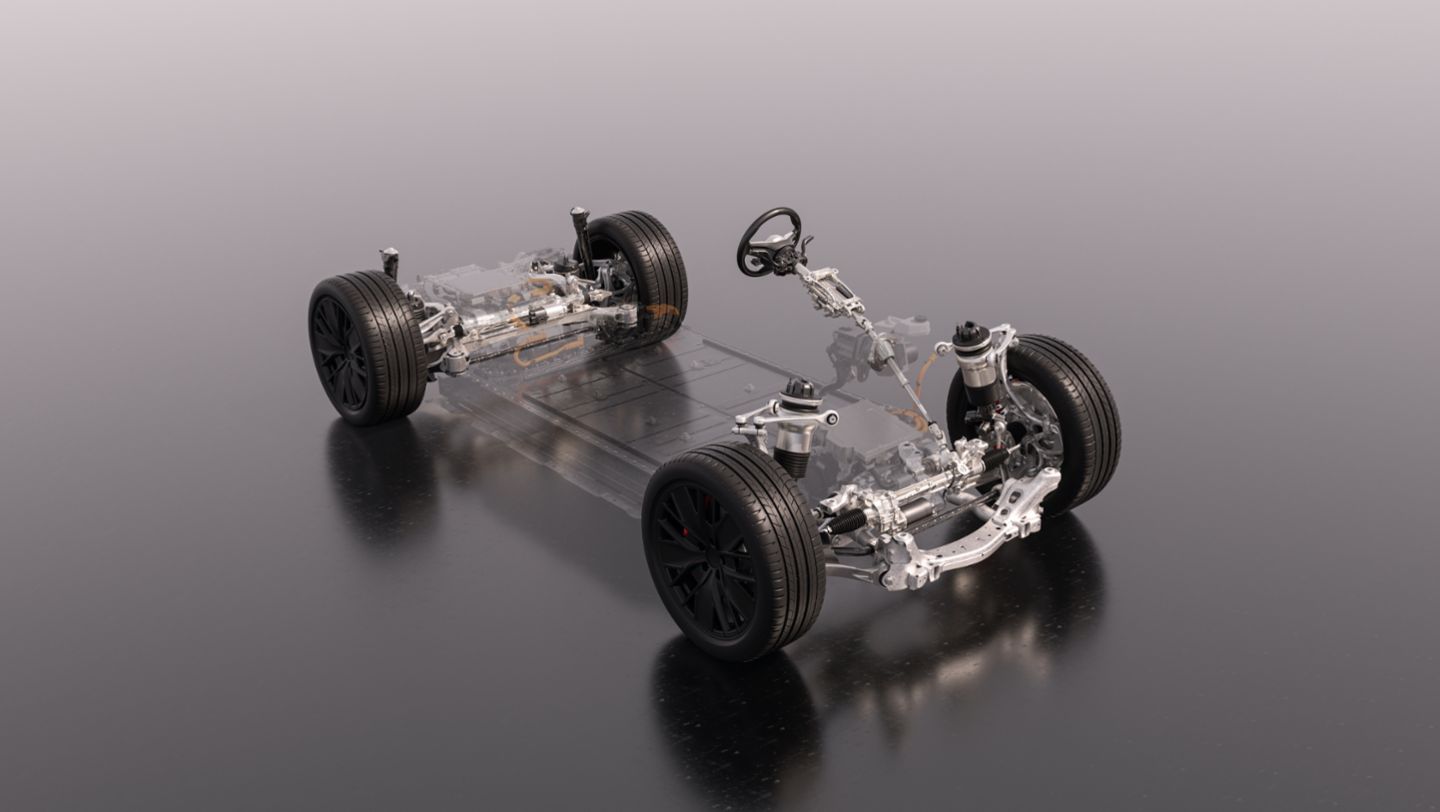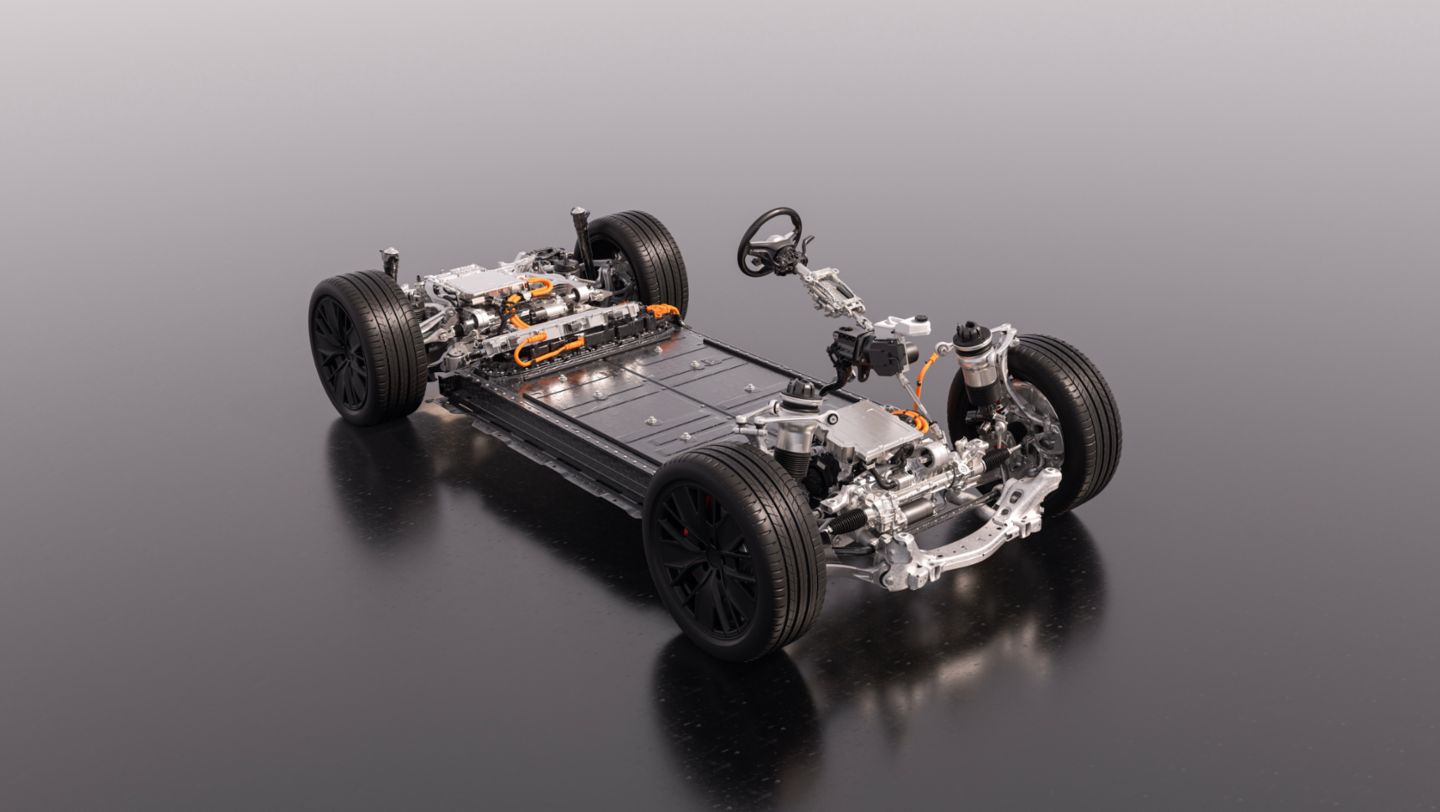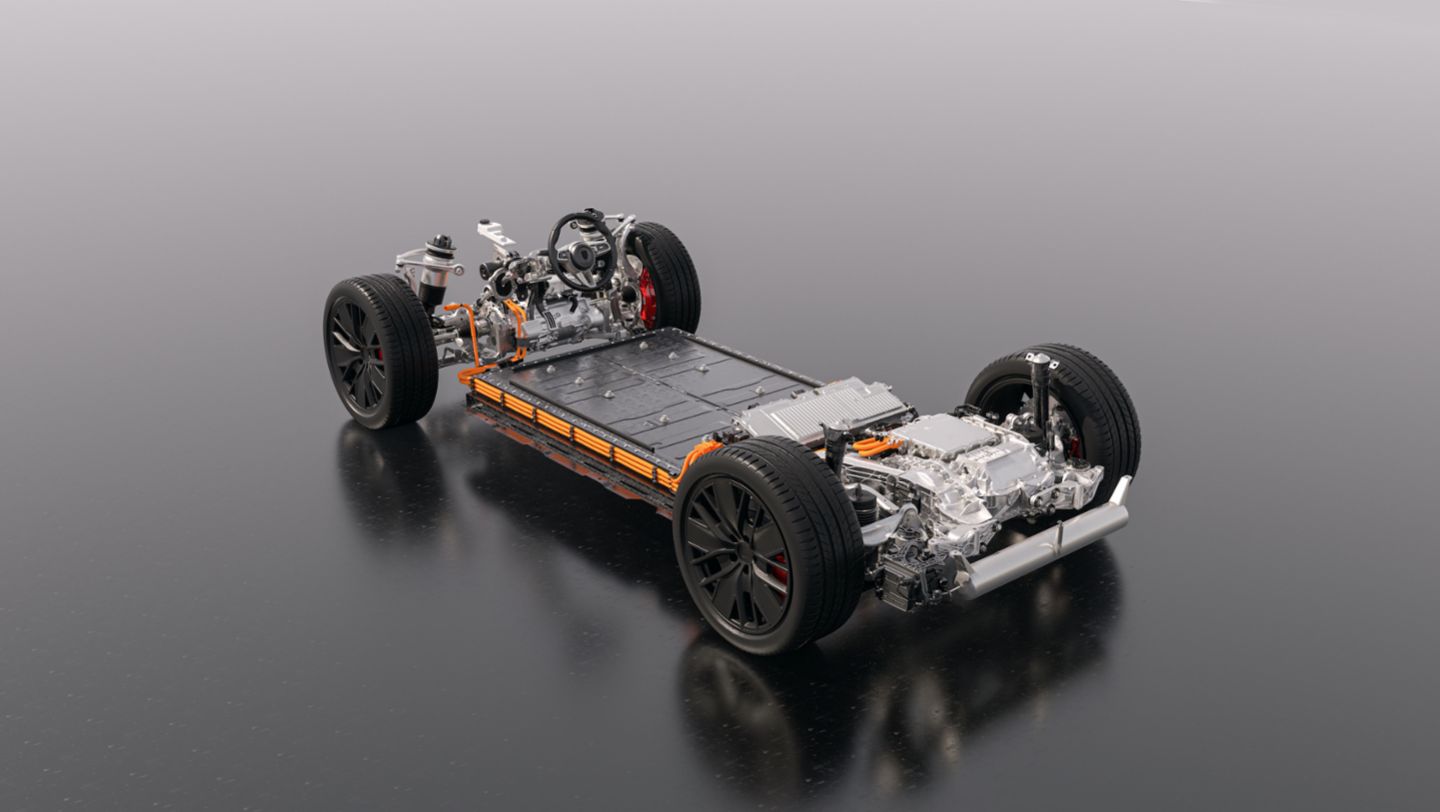This platform will give Porsche the opportunity to profitably market high-volume models to high technical standards and thereby electrify a further important part of the portfolio.
Developed together by Porsche and Audi
With PPE, Porsche and Audi have together developed an architecture for all-electric cars with which the benefits of a purely electric platform can be enjoyed in many ways – in terms of package and spaciousness, for example. At the same time, the architecture offers so much room for manoeuvre in the wheelbase, track width and ground clearance that it can be used to realise a variety of models – including in different segments. which simultaneously allows the flexibility for Porsche models to retain their strong, independent character.
The first Porsche based on the PPE will be the all-electric Macan. With its 800-volt architecture, the powerful electric motor of the latest generation, and state-of-the-art battery and charge management, this model offers the E-Performance that is characteristic of Porsche. The successor to the successful compact SUV will be the sportiest model in its segment. Along with reproducible best-in-class performance values, the development targets include long-range capability and high-performance fast charging.

For the top variants, the engineers are creating a dynamic, sporty driving experience with fully variable electronically controlled rear differential and a so-called ‘Performance rear axle’. Added to this is a powerful electric motor positioned behind the rear axle. This enables a rear-dominant all-wheel application across a wide spectrum. In combination with the dynamic torque distribution in the all-wheel drive, it also supports high agility when accelerating out of corners.
Powertrain: system output up to around 450 kW and torque of over 1,000 Nm
The PPE enables a wide range of models with rear- and all-wheel drive and various performance levels. The system output will initially go up to around 450 kW, with a maximum torque of more than 1,000 Nm.
As with the Taycan, Porsche is deploying the 800-volt technology for the next Macan generation. This ensures consistent high performance, significantly reduces the charging time, and lowers the weight of the high-voltage cables and the space required for them. A further common feature are the permanently excited synchronous electric motors (PSM) with hairpin winding used by Porsche. In this design, the rotor of the AC motor is fitted with permanent magnets that generate a permanent magnetic field in the motor. In comparison to asynchronous motors (ASM), PSMs offer higher power and torque densities, greater efficiency and better reproducibility of the power output.
In the all-electric Macan only the latest-generation PSM is to be used. To maximise the power density, the water jacket cooling was optimised in comparison to the Taycan. An example of the further comprehensive optimisations in the PSMs is what is known as the double V lamination – the arrangement of the magnets within the rotors.
The development of the power electronics has also taken a big step forward: to optimise the effectiveness, silicon carbide (SiC) is used instead of silicon as the semiconductor material in the pulse inverter (PWR) on the rear axle. This significantly reduces switching losses in the PWR and enables higher switching frequencies.
Battery: From five to 80 percent charged in less than 25 minutes
All electric Macan models have a lithium-ion battery in the underbody with a total capacity of around 100 kWh. This sizing is based on the Porsche philosophy. When looking at how to balance range, performance and sustainability, the company focuses on travel time. High-performance battery and charging technology is key here.
The battery in the future all-electric compact SUV from Porsche consists of twelve modules with prismatic cells. The mixing ratio of nickel, cobalt and manganese is 8:1:1, and the battery achieves a higher energy density. Thanks to 800-volt technology, the first PPE model series from Porsche it to be charged with an even higher charging capacity than the 270 kW of the Taycan. At a suitably powerful fast-charging station the battery charge level can be increased from five to 80 percent in less than 25 minutes.
If the station is using 400-volt technology, the all-electric Macan uses ‘bank charging’ for the first time, whereby corresponding high-voltage switches (gates) are automatically switched in the battery before the actual charging process begins. This effectively splits the 800-volt battery into two batteries with a nominal voltage of 400 volts each that can be charged in parallel on one 400-volt charging station without an additional HV booster. If necessary, the states of charge of the two battery halves are first aligned before they are charged together. The way the electronic components are packaged is also innovative: Porsche has applied for a patent for its Integrated Power Box which, in addition to the cables required and the weight, has also reduced the costs. The box saves space by combining three components – the on-board AC charger, the high-voltage heater and the DC/DC converter.
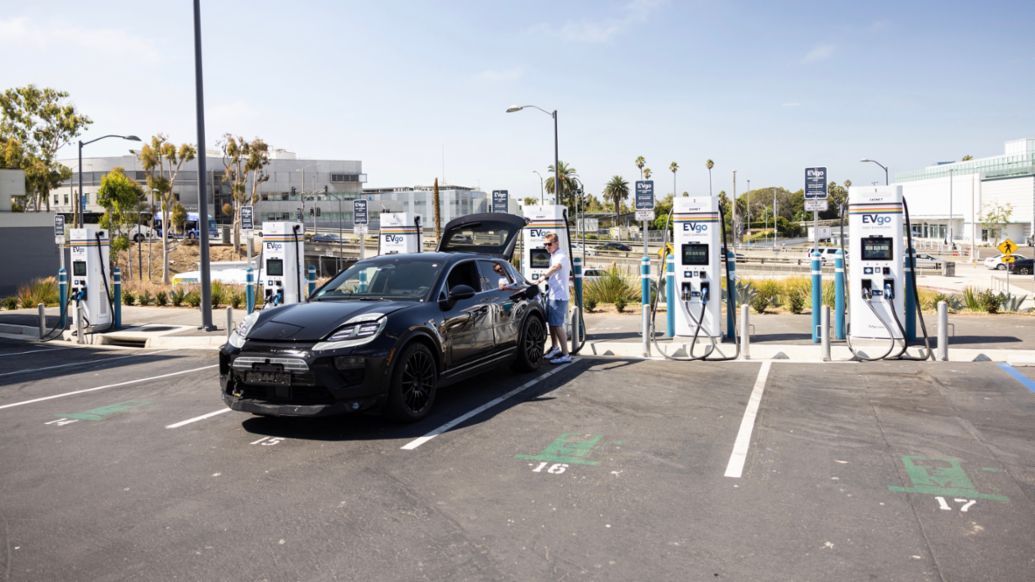
Even before the first Macan prototypes were built, the entire electric drive system, including the actual battery, was comprehensively tested on the high-voltage system test bench. This test bench is located in the drive test building in the Weissach Development System, opened in summer 2019, in which charging strategies and technology can be tested for different markets.
Chassis: quintessential brand driving dynamics and characteristic steering
Porsche will always be Porsche. This goes for the performance of the future PPE models and their expected driving dynamics. In the future compact SUV, depending on the model Porsche will be deploying a ‘Performance rear axle’. Here the electric motor is positioned particularly far back, resulting in a slightly rear-focused weight balance with the ratio of 48 to 52 per cent. In combination with the dynamic torque distribution of the all-wheel drive and the rear-axle steering, the powerful electric motors on the rear axle ensure agility when accelerating out of a bend.
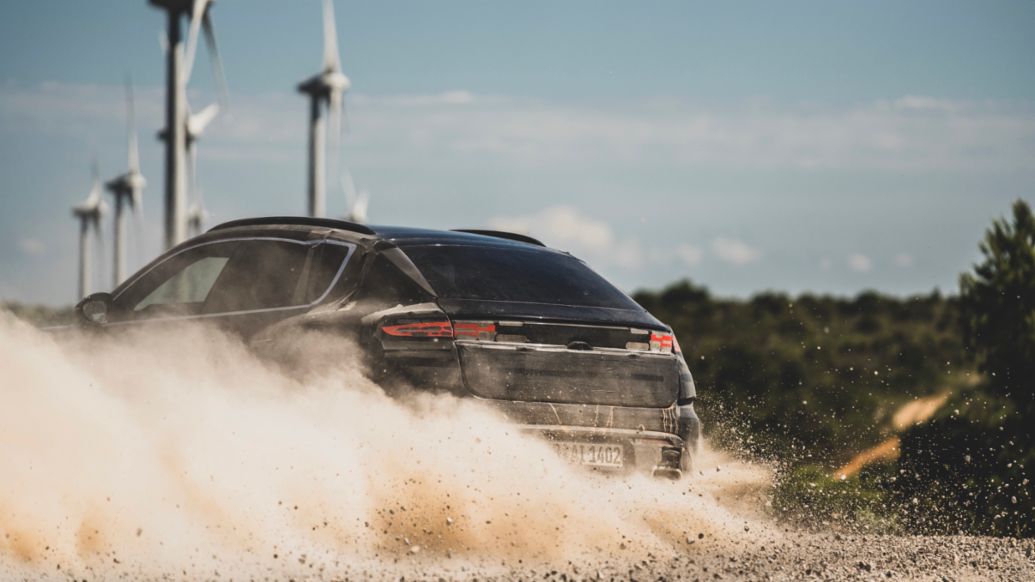
The all-electric Macan will have a completely revised double wishbone axle with detached strut level at the front. Its kinematics and elastokinematics enable improved responsiveness, steering precision and straight-line driving. The multi-link axle at the rear is connected to the body via an elastically mounted sub-frame, while the rear electric drive unit is fastened directly to the structure at four points – a special feature of the Performance styling at the rear. This has a positive effect on the driving dynamics with precise wheel guidance and high transverse rigidity, and on the NVH behaviour (NVH = Noise, Vibration, Harshness).
The top versions will have Porsche Torque Vectoring Plus as standard: an electronically controlled differential lock on the rear axle. This control strategy is independent of the respective driving situation and ensures greater traction, driving stability and transverse dynamics. The steering behaviour and precision are supported by targeted dynamic braking interventions on the rear axle.
Porsche Traction Management (PTM) uses the advantages of the all-electric powertrain
Porsche Traction Management (PTM) makes use of the conceptual advantages of the all-electric powertrain. Like the Taycan, the all-electric Macan will have an all-wheel concept with one electric motor per axle. The two electric motors enable fast, precise all-wheel control and a fully variable and – depending on the driving programme selected and the respective driving situation – demand-based torque distribution between the front and rear axles. This is beneficial to the steerability and the directional control of the front axle on the one hand, and on the other to the traction as the basis for the characteristic Porsche handling with high agility. Even away from paved roads, the Macan benefits from the optimised all-wheel distribution of the electronically controlled all-wheel drive.
This is beneficial to the steerability and the directional control of the front axle on the one hand, and on the other to the traction as the basis for the characteristic Porsche handling with high agility. Even away from paved roads, the Macan benefits from the optimised all-wheel distribution of the electronically controlled all-wheel drive.
At the same time, this packaging also enables the first rear-axle steering in a Macan. It resolves an old conflict of objectives and combines agility in urban traffic with stability and driving precision on the motorway.
At speeds of up to around 80 km/h, the rear wheels steer in the opposite direction to the front wheels, with a steering angle at the rear axle of up to five degrees. This virtual shortening of the wheelbase results in a more dynamic steering response when cornering. At the same time, manoeuvring is easier as the turning circle is reduced by around one metre. At speeds above approximately 80 km/h, the rear wheels steer in the same direction as the front axle. As a result, the wheelbase is virtually lengthened, further increasing the driving stability, for example when changing lanes on the motorway.
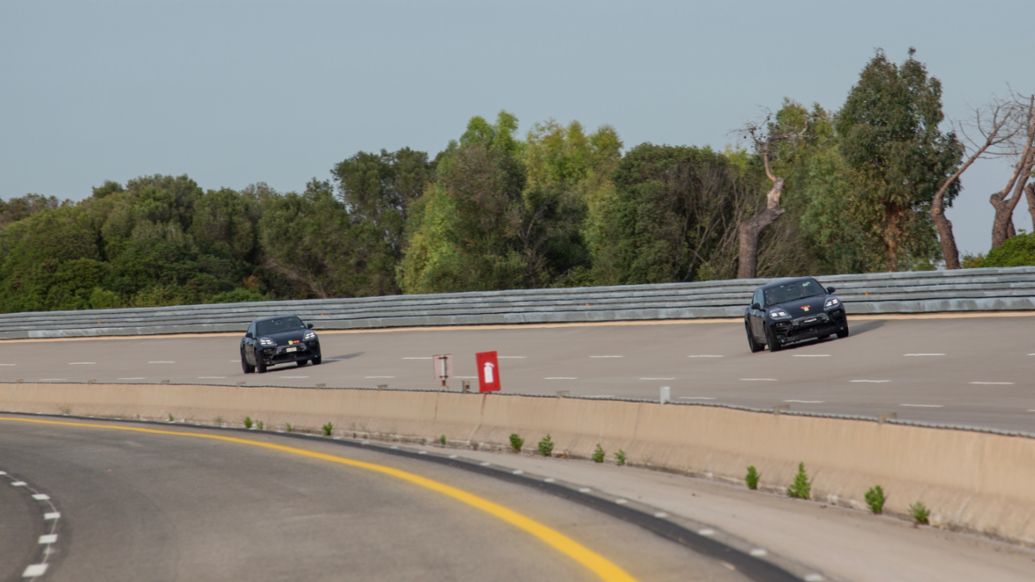
With rear-axle steering comes a 15 per cent more direct steering ratio to the front axle. Even in the basic version the front-axle steering already adheres to the uncompromising Porsche design, offering the highest precision for all steering manoeuvres. Combined with high actuator dynamics this results in optimum modulation. The power steering support developed in-house identifies and amplifies important steering information for the driver, such as the surface characteristics of the road and the grip capability of the tyres. Disruptive vibrations and bumps, on the other hand, are eliminated and not transferred to the steering wheel. The driver thus enjoys the clear, completely transparent steering experience characteristic of Porsche.
The electronic Porsche Active Suspension Management (PASM) is combined with the air suspension in the all-electric Macan, but may also be combined with the steel suspension. The system reacts to the condition of the road but also to the speed, longitudinal and lateral acceleration, accelerator pedal modulation, steering behaviour, and the position level of the car.
The electronic Porsche Active Suspension Management (PASM) offers improved performance
The two-valve shock absorbers will be a new feature in the PASM of the future Macan. On the one hand, they offer improved performance due to a significantly greater damper characteristic spread. On the other, two-valve shock absorbers can be adjusted independently of each other, providing an appreciable increase in comfort. This versatility makes the differences between the driving programmes even more tangible, putting each individual driving programme in the future Macan on its own distinct level. Additionally, depending on the speed, the body can be lowered in combination with the air suspension, and this improves the aerodynamics for increased range.
The wheel and tyre scenario in the future all-electric Macan is also typical of Porsche, especially when it comes to the mixed tyres, which will be even more pronounced than in the current model. The wheel widths on the front and rear axles will differ even more significantly in order to accommodate the rear-focused weight distribution – for more grip and driving dynamics. The wheel sizes of up to 22 inches will provide further performance potential.
